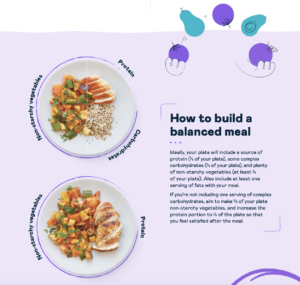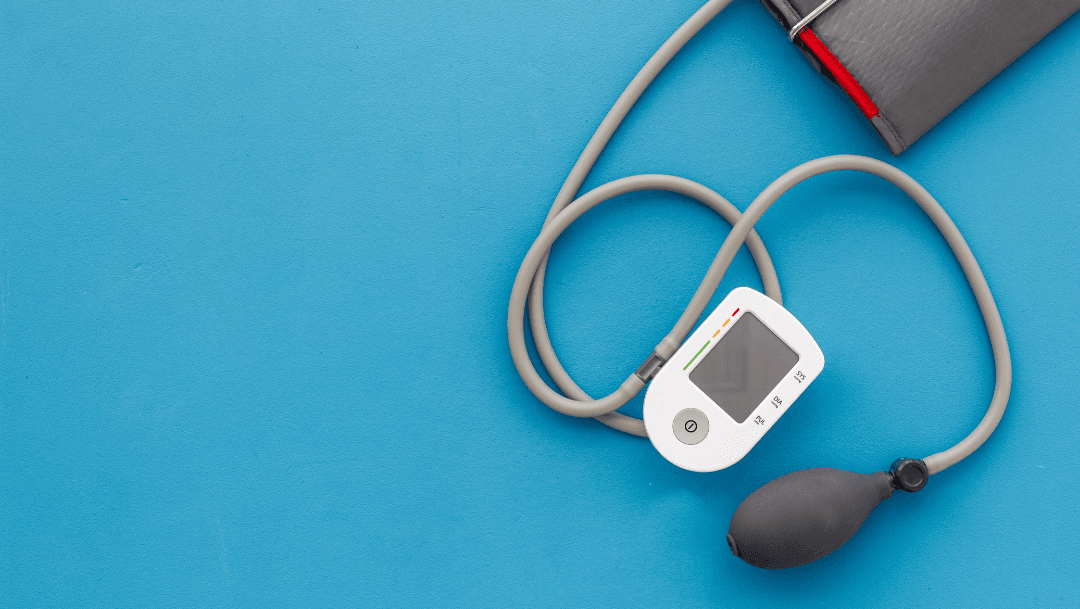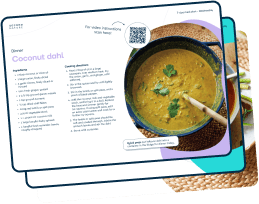Jump to: How to lower blood pressure | Eat a diet based on whole foods to lower insulin resistance | Increase your potassium intake | Stress management to lower cortisol | Take home message
You can get your blood pressure down quickly by eating a diet based on whole foods, increasing potassium intake by eating plenty of fruits and vegetables, and developing a more positive relationship with stress to lower the hormone cortisol.
Blood pressure measures how much pressure is placed on the walls of the vessels in your circulatory system, such as your arteries and veins, and it’s a significant risk factor for cardiovascular disease. It’s measured in units of millimetres of mercury (mmHg), and there are two ways that blood pressure is displayed:
Systolic mm/Hg (<120 normal): the pressure when the heart beats
Diastolic mm/Hg (<80 normal): the pressure when the heart relaxes
How to lower blood pressure
Salt (sodium) has been labelled as the primary agent causing high blood pressure. However, recent research has suggested that while reducing salt intake can lower blood pressure by a modest amount in some people (if you’re salt sensitive, for example), it may not be the most effective way to treat the underlying causes.
The causes and factors influencing our blood pressure are complex. Still, one of the problems observed in people with high blood pressure is that their kidneys seem to hold onto more sodium, which can lead to our body retaining excess water, increasing blood pressure over time.
Another issue is vasoconstriction, where your blood cells ‘tighten’ or ‘stiffen’, which makes it difficult for blood to flow through your system; this leads to your heart having to pump harder (increasing blood pressure) to try and counteract this effect.
So, if we can improve our kidney’s ability to excrete excess sodium, manage fluid balance, and reduce stiffening in our vessels – we’ll likely see improvements in blood pressure.
Research has shown that high insulin levels (insulin resistance), high cortisol levels, and a low potassium intake can all lead to the kidneys holding onto more sodium and increasing blood pressure.
Excess cortisol and low potassium intake can also lead to vasoconstriction. High cortisol levels and low potassium inhibit the production of a molecule called nitric oxide, which prevents vasoconstriction by relaxing the walls of our blood vessels, improving circulation, and lowering blood pressure.
So, here are three evidence-based ways you can lower your blood pressure:
1) Eat a diet based on whole foods to lower insulin resistance
Whole-food diets have been shown to improve insulin sensitivity and lower blood pressure, whether low-fat diets like the DASH diet, Mediterranean diets, or lower-carb diets. Your blood pressure will likely improve if they are based on whole foods.
However, recent research has shown that diets higher in fat and lower in carbohydrates help lower your blood pressure and are more effective at reducing insulin resistance and improving other markers of health linked to cardiovascular disease than low-fat diets.
Click here for an NHS-backed 7-day meal plan.
2) Increase potassium intake
Potassium helps to lower your blood pressure in a couple of ways:
- It seems to increase sodium excretion out of your urine, helping to manage sodium levels in the body.
- It relaxes your blood vessel walls.
Eating a wide variety of fruits and vegetables can ensure you’re eating enough potassium, and here are three foods rich in potassium to include in your diet:
- Spinach
- Potatoes (both white and sweet)
- Beetroot
3) Stress management to reduce cortisol
Cortisol seems to have an impact on blood pressure in three main areas:
1) It can make insulin resistance worse
2) It increases sodium retention in the kidneys
3) It reduces your body’s production of nitric oxide, which lowers blood pressure by expanding your blood vessels and improving blood circulation.
Here are two evidence-based ways to lower cortisol levels:
1) Make stress your friend: building a positive relationship with stress can lower circulating cortisol levels.
2) Embracing calm, too: calming activities such as Tai Chi, meditation, reading, socialising, accessing nature, and playing music have all been shown to lower cortisol levels.
At Second Nature, you’re supported by a registered dietitian or nutritionist to help you improve your health and blood pressure through changes to your lifestyle.
We’re not here to give you a quick fix but a long-term alternative to improving your health. Join people like Catherine, who’ve improved their blood pressure and made weight loss feel easier since joining Second Nature.
Otherwise, keep reading as we look deeper into three evidence-based ways to lower your blood pressure in the long term.
Medication-assisted weight loss with a future focus
Start with Wegovy or Mounjaro, transition to habit-based health with our support


1) Eat a diet based on whole foods to lower insulin resistance
Many diets have been shown to lower blood pressure. From low-fat style DASH diets (dietary approaches to stop hypertension), to Mediterranean, and low-carbohydrate, plenty of options are available to help you lower your blood pressure.
If a diet is based on whole foods, it will probably lower your blood pressure. This was demonstrated by a meta-analysis that analysed four different dietary approaches and their impact on blood pressure. It showed that all of the diets analysed can positively impact blood pressure and that the most crucial factor was the quality of the diet.
However, blood pressure is just one marker of our health, and we must reflect on other factors that influence our health to choose the best diet we can sustain for the long term, not just for short-term reductions in blood pressure.
Insulin resistance has been shown to lead to greater sodium retention in the kidneys, which can increase blood pressure in the long term. Diets higher in fat and lower in carbohydrates have been shown to improve insulin resistance and other markers of cardiovascular health to a greater extent than low-fat diets.
A randomised controlled trial compared a lower-fat DASH diet to a higher-fat DASH diet to determine their effects on weight loss outcomes and other risk factors for cardiovascular diseases, such as very-low-density lipoprotein (VLDL) and triglycerides.
The study showed that both the lower-fat and higher-fat DASH diets improved blood pressure to a similar degree. But interestingly, the higher-fat DASH diet saw more significant reductions in VLDL and triglycerides.
Reductions in VLDL or triglycerides are often observed when insulin resistance improves. For example, a randomised controlled trial compared low-fat, Mediterranean, and low-carbohydrate diets on cardiovascular risk markers.
The study showed that the diets higher in fat (the Mediterranean and low-carb) improved insulin resistance to a greater degree than the low-fat diet and saw more significant reductions in triglycerides.
So while many diets can achieve reductions in blood pressure, diets higher in fat seem to improve insulin resistance and other markers of our health, such as our triglyceride levels, to a greater extent than low-fat diets while having comparable improvements in blood pressure.

Key points:
- Many diets based on whole foods have been shown to improve blood pressure.
- However, blood pressure is just one measure of our health, and it’s essential to look at other factors.
- Insulin resistance has been shown to worsen blood pressure by leading to excess sodium retention in the kidneys.Diets
- higher in fat have been shown to improve insulin resistance to a greater extent than low-fat diets while having comparable effects on blood pressure.
2) Increase potassium intake
Potassium, a mineral and an essential component in our diet, helps lower your blood pressure by regulating fluid balance, supporting your kidneys to extract sodium, and increasing nitric oxide production; this molecule relaxes the walls of your vessels and aids circulation.
Early studies on the DASH diet indicated that increased potassium intake, primarily from eating more fruits and vegetables, may help to improve blood pressure without changing the amount of salt in your diet.
Further trials using potassium supplementation have confirmed that potassium can improve blood pressure without changing other aspects of people’s lifestyles or diets.
A study found that a daily potassium supplement for just one week reduced systolic blood pressure by 11mm/Hg and diastolic by 12mm/Hg in individuals living with hypertension.
In comparison, a randomised controlled trial compared the effects of a DASH diet with low, medium, and high salt intakes on blood pressure after four weeks. The results showed that consuming low levels of salt (less than 2g per day) compared to high (more than 6g per day) reduced systolic blood pressure by 3mm/Hg and diastolic by 1.6mm/Hg.
This suggests that potassium intake, rather than sodium (salt) intake, has a more significant influence on regulating fluid levels and blood pressure.
Alongside supplementation, potassium can be found in a wide variety of fruits and vegetables, and having a variety of fruits and vegetables in your diet can ensure you’re getting enough potassium.
Here are three foods rich in potassium that you could add to your diet if you have high blood pressure:
- Sweet potatoes: 508mg per 100g
- Beetroot: 325mg per 100g
- Spinach: 256mg per 100g
Key points:
- Potassium helps to lower blood pressure by supporting fluid balance, sodium excretion, and relaxing blood vessels.
- Clinical studies have shown that increasing potassium intake can help to lower blood pressure without changing salt intake.
- Studies on potassium supplementation have shown potassium seems to have a more significant effect on reducing blood pressure than salt.
- Supplementation and consuming a wide variety of fruits and vegetables are the best way to increase potassium intake.
3) Stress management to reduce cortisol
Stress is a complicated topic. We’ve previously been told that stress is bad for our health and that we must reduce it at all costs. While managing stress and ensuring a positive work-life balance is essential, we might also benefit from embracing the positive side of stress.
Recent research shows that people who embrace stress as an opportunity to learn, improve, and better themselves, are more likely to live longer and score higher on quality of life scores.
This was illustrated by a study that tracked people over time to see how their perception of stress impacted their mortality risk. It showed that people who rated themselves as having high levels of stress but believed it was positive had a 17% lower risk of death than those who viewed it as a negative.
So how can you make stress your friend? Positive affirmations
Our brains are wired to think negatively, and because we’ve been conditioned to believe stress is bad for us, the first thoughts that come to mind when we feel stressed are often negative.
However, research has shown that we can train our brain to think more positively, ultimately changing how our body reacts to stress. The next time you feel stressed or have strong emotions, repeat some of the following affirmations:
- My heart is racing because it’s pumping oxygen around my body to prepare me to perform.
- I feel hot and sweaty because my body’s releasing energy into my bloodstream to help me perform.
- This situation is stressful, but my body will give me the courage to respond, learn, and adapt.
Embracing calm too
While embracing stress can positively impact how you manage it in the long term, it also helps to embrace opportunities to have some downtime. This has also been proven to reduce cortisol levels and improve stress management.
The impact of calming activities on cortisol and blood pressure was demonstrated in a randomised controlled trial that investigated how these would change following a Tai Chi intervention (an activity that combines martial arts and meditation) compared to a control group with no intervention.
The trial showed that cortisol levels decreased by 11.1%, and systolic blood pressure dropped by 8mm/Hg in the Tai Chi group. Compared to the control group, where no improvements were observed.
Other calming activities that have been shown to reduce circulating cortisol levels include accessing nature, social bonding, and mindfulness meditation. You could also try reading, socialising, and playing music.
Key points:
- Reducing cortisol levels can help to lower blood pressure.
- Our brains are wired to think negatively, and we’ve been conditioned to believe that stress is bad for us.
- Research shows that embracing stress and using it as an opportunity to learn and adapt can benefit long-term health.
- Positive affirmations are a way of improving your relationship with stress.
- Doing Tai Chi, accessing nature, social bonding, and mindfulness meditation are all proven ways to improve stress management and lower cortisol levels.
- Other calming activities such as reading, socialising, and playing music could also help.
Take home message
Like many health conditions, blood pressure is complicated, and many different factors within the body will affect it. And despite what we’ve often been told, it might not all be about how much salt you eat.
The connection between salt and blood pressure is a good example of where we’ve tried to oversimplify recommendations and missed the bigger picture. High blood pressure seems to be more about what’s preventing the body from excreting salt (sodium) and what’s causing your body’s blood vessels to tighten and stiffen.
While reducing salt intake can have modest effects, particularly in salt-sensitive individuals, by reducing your insulin resistance, cortisol levels, and increasing your potassium intake, you’ll be targeting the underlying causes to improve your health in the long term.


